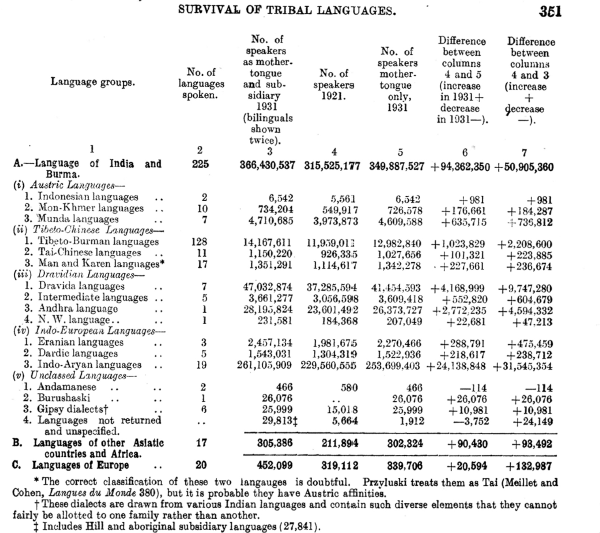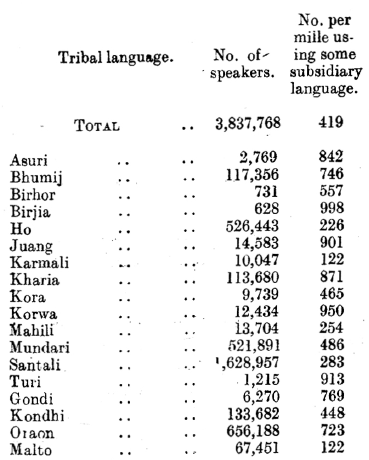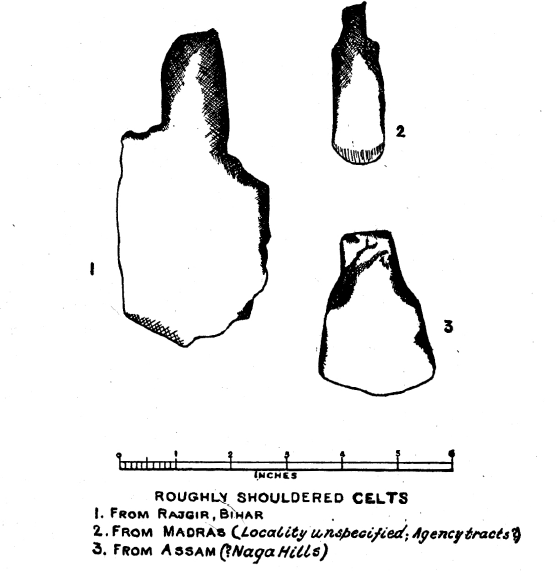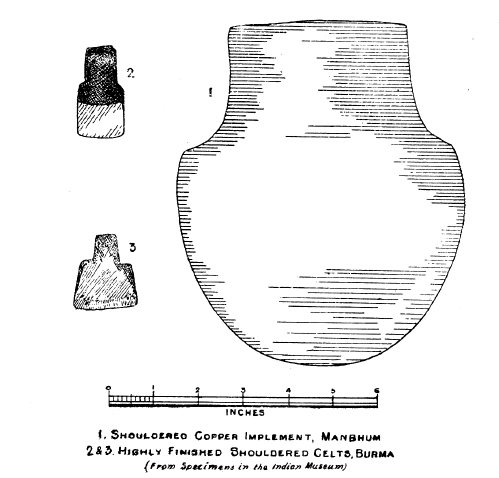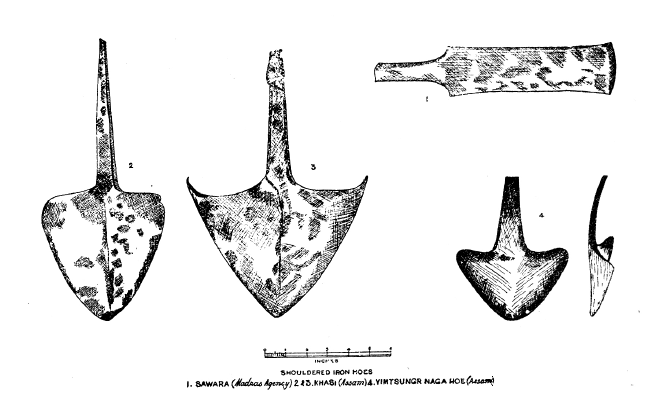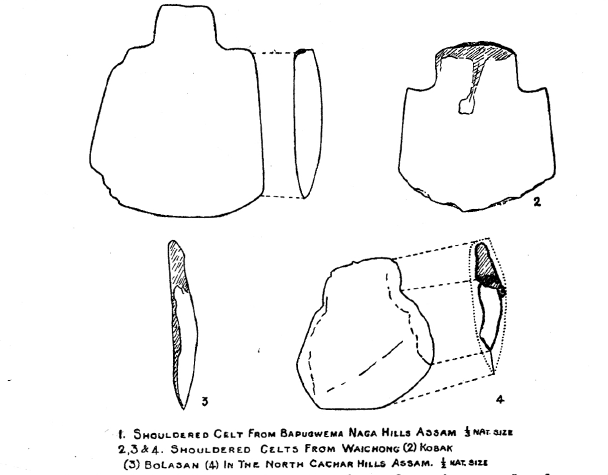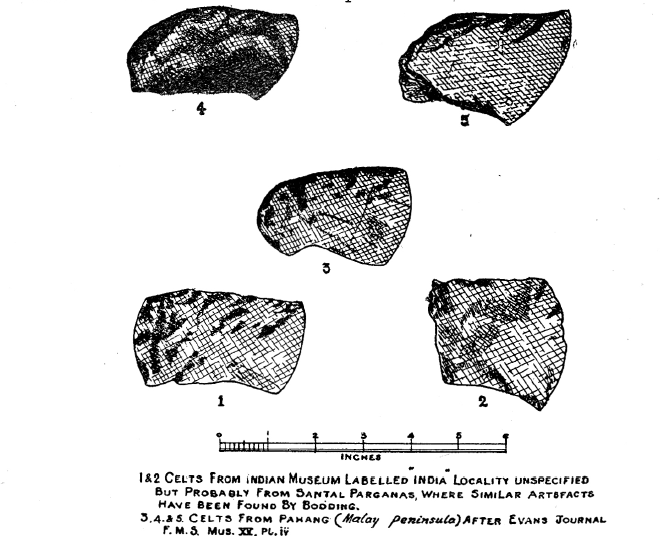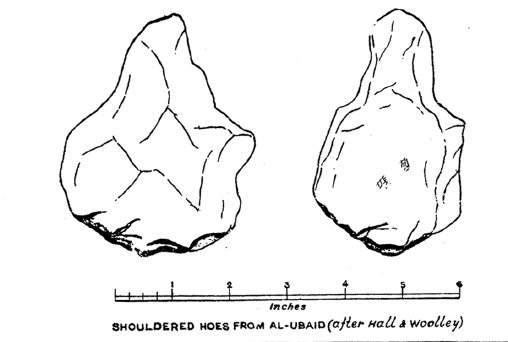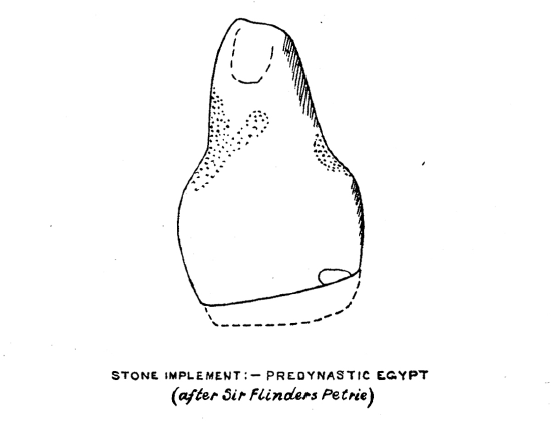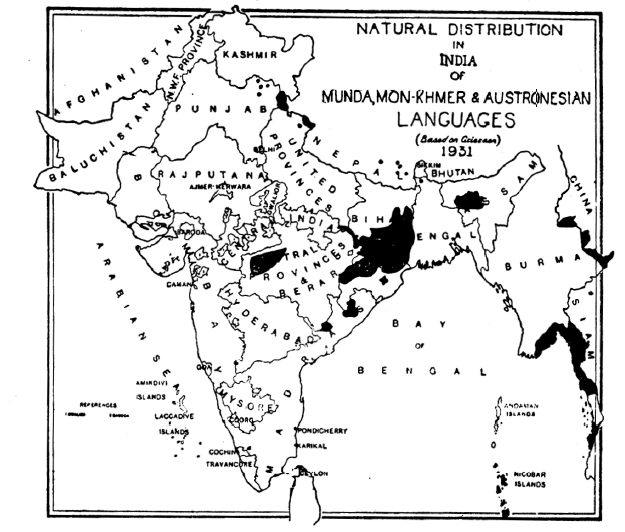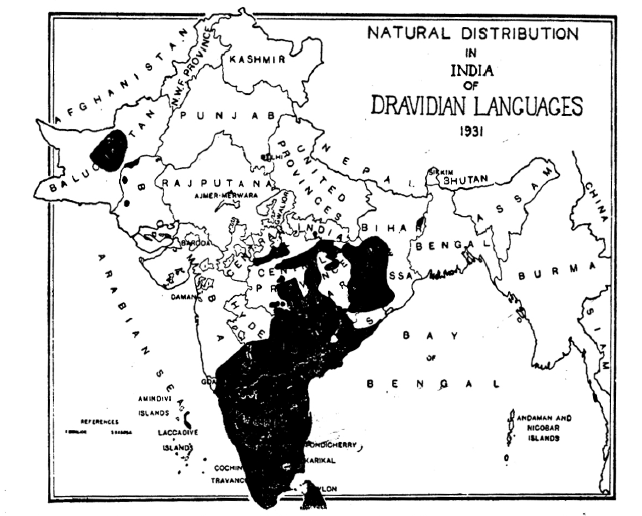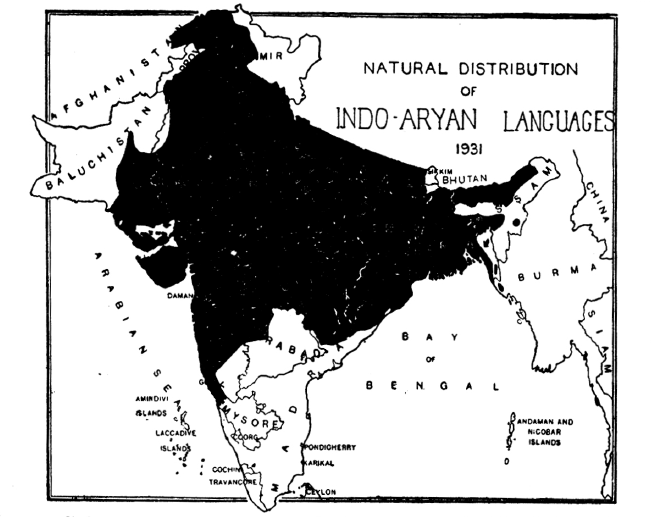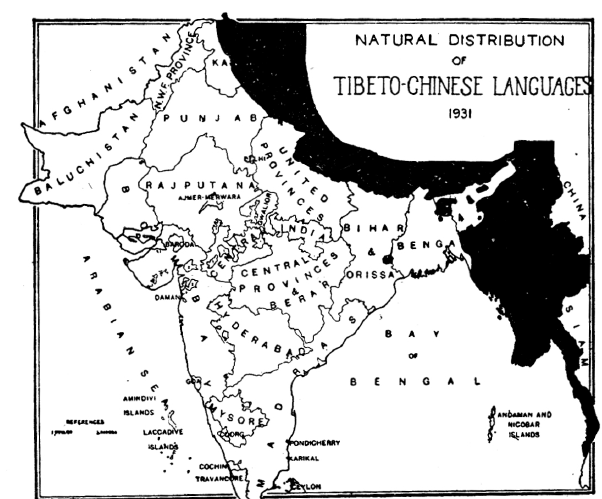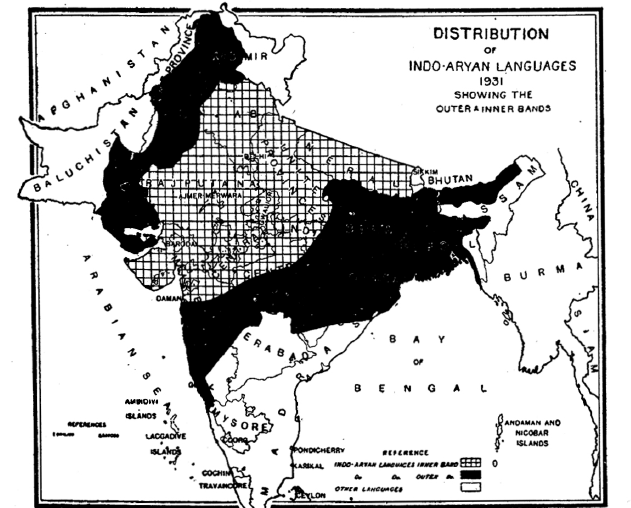Census India 1931: Language
This article is an extract from CENSUS OF INDIA, 1931 Report by J. H. HUTTON, C.I.E., D.Sc., F.A.S.B., Corresponding Member of the Anthropologische Gesselschaft of Vienna. Delhi: Manager of Publications 1933 (Hutton was the Census Commissioner for India) Indpaedia is an archive. It neither agrees nor disagrees |
Contents |
Section I, - The Returns
Extension of the language return
For the return of language in the 1931 census two columns were provided— one for the speakers of mother-tongue, and the other for any language or languages habitually spoken, in addition to the mother-tongue, . in daily or domestic life. Infants and deaf and dumb persons were to be credited with the same language as their mothers. The distribution and classification of Indian languages has been so exhaustively dealt with in the Linguistic Survey of India, the very important introductory volume to which appeared as recently as 1927, that little remains for a census to do with regard to the main languages of the country beyond recording their corresponding increase and decrease, since the area of any given tongue is hardly ever stable. In one respect, however, existing information was lacking and that was the extent of the overlap of different languages in the numberless areas in „-hick two or more co-exist.
It is not suggested that this overlap is a permanent feature, and that areas speaking two languages at present will necessarily continue to do so in perpetuity, but in view of the not unreasonable desire of many -Indians for a redistribution of provinces on a linguistic basis, as well as of the possibility of extensions of franchise to very considerable populations speaking some tribal language as their mother-tongue, to say nothing of the desirability of starting all primary education in the real language of the child to be taught, the record of this overlap has more than a purel y academic interest. Moreover, apart from linguistics, the extent of the survival of tribahlanguages is a better index than that of the survival of tribal religion to the social cohesion of the tribe, since the test of language is easier and more definite than that of religion where the borderland of Hinduism is often vague and obscure. As a matter of fact the material collected of the distribution of mother-tongue and subsidiary language's in Orissa irredenta and the coasts thereof was requisitioned by the Orissa Boundary Committee before it had been extracted from the schedules, and it was only by working himself and his staff to the verge of collapse that the Superindendent of Census Operations in Madras was able to provide adequate data in time for the Committee to use it.
Subsidiary Language and Orissa boundaries
In the case of Orissa unfortunately the very facts which the census schedule was designed to elicit operated towards impairing its value. This was on account of the stupid and unintelligent propaganda which was deliberately directed to misrepresent as Oriya what was not Oriya, or as non-Oriya, what was. The result of this propaganda was the sort of foolishness which made both enumerated and enumerator ' plump ' for one language.
If a man spoke Oriya as an alternative language with, say, Bengali as his mother-tongue he would ret urn his mothertongue as Bengali and perversely return Bengali again in the subsidiary column for fear of giving support to the Oriya case. Vice versa Oriya speakers equally at home in Telugu would conceal the fact by returning Oriya in both columns. Of the various agitators the Ori.yas were easily the worst. So high did feeling run in the Orissa boundaries of Madras that special officers had to be appointed to superintend enumeration and abstraction. Nevertheless the return of subsidiary language, incomplete us it was, made it possible to indicate clearly enough the debatable areas where two languages were spoken and must have been of very considerable value to the Boundary Committee. The general percentage increase in Oriya-speakers since 1921 is in close relation to the average increase in 'population, and the consistency of the language returns in Ganjam as compared with those of previous censuses, excepting always that of 1901, indicates their general accuracy The marginal table gives the figures from 1881 onwards taking in 1931 the total speakers of Oriya by mother- tongue only.
If those speaking Oriya as a subsidiary language be added, it makes a total number of persons having a command of the Oriya language of 1,184,909—that is of no more than 57 .7 per cent. of the population of the Ganjam plains, to which the figures relate, as compared to the 52.6 per cent. whose mother-tongue it is, but it is probable that th,re has been some understatement both of Oriya and of Telugu in the return of 0ibsidiary language, as Oriya-Telugu bilingualism is extensive. The inaccuracy of tit, 1901 figure was recognised at the time, and actually during the course of compilation a reference was made to the Census Superintendent as to the return of Reddiki, a Telugu caste, as Oriya speakers.
The compilation was however continued in accordance with the return in the schedule. The Madras Government had a special enquiry, made in 1904 as to the language returns of 1901 and reported that the inaccuracy of the census figures in that year was due to the desire of Telugus to participate in the special advantages given to encourage the education of Oriyas ; to the belief that it was easier for Oriyas to obtain Government service than for Telugus ; and to the fact that there were more Oriya enumerators than Telugu, that they would ask their questions in Oriya, and would probably put down as Oriya speaking all who answered in that language. Ganjam is predominantly bilingual and the return of subsidiary language was first introduced in 1931. So deep does bilingualism go in parts of Ganjam that from very infancy many grow up speaking both Oriya and Telugu and are so much at home in both that they cannot tell which to return as their mother-tongue. Some officers unfamiliar with this phenomenon found difficulty in appreciating the fact that small children can be bilingual, and rejected returns of a subsidiary language under the age at which they considered it possible for a child to have learned a second one thoroughly, but in point of fact it is perfectly possible for a child to be bilingual from his first learning to speak, and the phenomenon is familiar in some parts of India, where marriages between persons of different linguistic groups are common. The late Khan of Kalat spoke Brahui to his mother and Balochi to his father from infancy, and children lisping in two radically different tongues are common enough in the hills of Assam.
Billingualism
Elsewhere than in and about Orissa the subsidiary language return was fortunately not coloured immediate politics, though not always free from political bias, as in the case of Bhopal State, where Urdu was returned " in deliberate disregard of the actual facts " in order to give effect to a sentiment that Hindus as well as Muslims living in that State ought to have the peculiarly Muslim variety of Hindustani as their mother-tongue instead of Bajasthani and even instead of Gondi.
A similar sentiment caused Muslims in many parts of India to return Urdu (Hindustani) as their mother-tongue and the local vernacular as their subsidiary language though the precise opposite was the real fact ; and _ the same sort of feeling was , at work in the case of sonic Gonds who, considering Gondi of inferior social reputation, returned Halbi, a Marathi dialect, as their mother-tongue, giving Gondi, if at all, as subsidiary. In fact Mr. Grigson, when Administrator in Bastar State in 1930, stated that it was common for Gonds to affirm in court that they knew no language but Halbi, when as a matter of fact their wives and mothers coming to give evidence would be found to understand no tongue but Gondi, on which husbands and sons would admit that they did speak Gondi in their homes. The first stage in the disappearance of any language is the use of another as well in ordinary daily intercourse, and in cases of this kind it is probable that the provision for the return of a second language has extended the area of record of many of the hill and jungle languages now in the process of becoming submerged, a process likely to be much accelerated by the ubiquitous increase of easy communications.
It has proved impossible to plot this overlap with precise reference to the numbers involved on a scale small enough to reproduce as an all-India map for this volume. The linguistic map therefore which accompanies this report deals only with the distribution of mother-tongues, and for detailed information as to subsidiary languages the student is referred to the various provincial reports in all of which, except in that for the United Provinces, where Hindustani alone is spoken, will be found a map showing the distribution by population figures not only of mother-tongue but of the actual numbers speaking various subsidiary languages in each district and in some cases in even smaller units. In the provincial volumes (Table XV, II) will be found the details of subsidiary languages by the smallest territorial units forwhich it was practicable to give them where such languages were not evenly distributed over a district or larger area. A summary of this information will be found in Table XV (ii) , in pars ii of this volume and in the corresponding subsidiary table at the end of this chapter.
Changes in classification
A few alterations of minor importance have been made in the classification of languages as compared with that of 1921. India thus appears with 225 of 222 languages although the Tibeto-Burman Sub-family is credited with only 128 instead of 134 languages. This reduction of six, increased to seven by the omission of unspecified Pahari, is more than balanced by an addition of one to the Eranian branch—Persian, a dialect of which is the mother-tongue of a number of villages in Baluchistan, having here been added to the vernaculars of India ; of one to the Dardic branch, that is of Bashgali in the Kafir group which did not appear at all in 1921 ; of one to the southern group of the Indo- Aryan branch, Konkani being treated as a separate language and not (as in 1921) as a dialect of Marathi ; and of seven to the unclassed languages, Burushaski appearing for the first time, Andamanese being shown as two languages instead of one (since the language of the Jarawas, Sentinelese and Onges differs much from that of the Great Andaman coast tribes), and the unclassed Gipsy tongues appearing as six instead of one, though there has been no change in nomenclature or classification except that they are not pooled as in 1921. In the case however of the Tibeto-Burman languages there are changes in grouping and nomenclature which need to be stated. In the Bodo group the speakers of the language shown in 1921 as " Tipara or Mrung " have been returned partly under the same head and partly under the term Tsakchip in the Old Kuki sub-group of the Kuki-Chin group.
In the Naga group Khoirao and Marami have been merged in Memi (.----"Sopvoma or Mao " of 1921), and Chang, the cis-frontier speakers of which are very . few, in the new term Other Eastern Naga languages, which includes also Phom and some trans-frontier languages spoken by casual individuals found inside the• frontier at census time. Mikir has been put in a group by itself, as besides having affinities to the Kachha Naga and Kabui languages it has strong affinities to the Bodo tongues and some to the Kuki ones. Maring has also been omitted from the Naga-Kuki sub-group and shown in the Old Kuki , sub-group of the Kuki-Chin group, with which it seems to have at least as much affinity as with the Naga. In the Kuki-Chin group there have been changes of nomenclature and amalgamation resulting in the disappearance from the list of Purum, Hiroi-Lamgang, Chote, Vaiphei, Kamhow, Laiyo, Kwingly, Yokwa, Kaungtso, Kwelshin, Hualngo, Kyaw and Taungtha, and in the addition of Pankhu, Chinbok, Chinme, Rongtu and Tsakchip as well as of Mating transferred from the Naga group. Sokte now includes Kamhow, Thado includes Jangsen, Lai includes Kaungtso, Kwangli, Kwelshin, Tlangtlang, Laiyo and Yokwa, and Tashon includes Hualngo. The Man and Karen languages probably have affinity with the Mon-Khmer, with which indeed they were actually classified in 1911, but they are also reported to have Tai characteristics and the combination may be due to contact or to the amalgamation of tribes.
They have been associated this time for convenience with the Tibeto-Chinese family, as Przyluski treats them as affiliated to the Tai. Information on these and on the other groups of Burma languages is still very scanty as the Linguistic Survey of Burma has never been carried out. Among the' foreign languages (C. Languages of Europe) is included a number of persons who returned their mother-tongue as " Swiss". This however is not a new international language, but appears to be a relic of war-time mentality and an euphemism accordingly for ' German'; to which category they have been added in the detailed table. From somewhat similar motives, perhaps, Flemish seems to have been returned as " Belgian ". Some slight alterations in the classification adopted in provincial and state reports have been made in the India tables.
The speakers of Palaung (842) and Pale (114) returned from the Chittagong Hill Tracts, Tripura State and elsewhere in Bengal cannot apparently be correct, as all the Palaungs are located in the Shan States to the east of Burma.
I have therefore no doubt whatever that Palaung should have been classified as Palaing, the name of a Kuki- Chin clan in the area from which the returns are made. Pale is more doubtful. It may be the name of another clan—there is certainly one called Palow—or it may be a return of Pali made by Buddhist priests in the spirit that provokes many returns of Sanskrit by learned Hindus or of Arabic by Muslims ; in any case it is most unlikely to be the Pale of the Palaung-Wa country.
Survival of Tribal Languages
The table above shows in a very general way the linguistic position and the importance therein of the subsidiary language return, but it is really only by reference to the various provincial reports that individual areas can be dealt with. There are far too many languages and dialects in India to treat individually without prolonging tl4is chapter to an inordinate length. The question however of tribal languages and of their survival or displacement is of such interest, at any rate in several provinces, that no justification is required for quoting here at length from the provincial reports to which reference must be made for details. The Census Superintendent for the United Provinces draws attention to the disappearance of gipsy languages :- "These gypsy languages are dying out in this province.
These wandering tribes are taking to a more settled manner of living, cultivation and the like, and with this change comes the need to use the language of their neighbours. As a result the majority of the present members of these tribes have never learnt these dialects, but speak from their youth some form or other of Hindustani ...... even those who returned a gypsy language as mother-tongue in,every case returned Hindustani as subsidiary language." And the Census Superintendent of :Mysore State reports precisely the same phenomenon. Of tribal languages in Central India the Census Superintendent of the Central India Agency writes as follows :-
"Despite the presence of a large Tribal population in Central India, the question of the non-Aryan dialects giving place to the advancing tide of Aryan culture and civilization does not present itself for the very obvious reason that the process of displacement has already taken place, perhaps a long time ago. The Kol, Baiga and other Munda tribes in Rewa, the Sonr in Bundelkhand, the Saharia in northern Malwa and Gwalior, have in the present day no languages of their own. They speak the Indo-Aryan vernacular of the locality in which they reside. Whether the Bhil had a language of his Own we do not know. Probably the basis of his language was Munda but his present language is throughly overlaid with an Aryan superstructure The Gondi (so-called) of Rewa is practically a broken Bagheli. If that be so, the Aryan language has already supplanted the language of the Gonds. The small number of Korkus who live in the villages in the Narbada valley have practically abandoned their language and speak Malvi."
For the tribes in Banda the Census Commissioner for that State points out that where the members of a tribe have no economic independence, Hinduization involves the loss of the tribal language. Thus Gujarati is rapidly supplanting, if it has not supplanted, the Bhili dialects of the Dublas and Talavias, who are agricultural labourers dependent on Gu j arati-speaking masters. But on the other hand where there is economic independence with a consequent social consciousness the tribal language survives Hinduization and value is attached to its retention, as for instance by the Chodhras.
This helps to explain the obvious vitality of tribal languages in eastern India in spite of the rapid Hinduization of the past decade. This vitality is on the whole pronounced in the Central Provinces, in Bihar and Orissa, in Bengal and in Assam. though there are one or two excel- tons in each of these provinces. At the same time bilingualism is on the increase and there can be little doubt of the ultimate fate of these tribal languages. The Census Superintendent for the Central Provinces writes :—
" In border areas poly-linauism is in fact frequently encountered. A well-known, but humble, Gond shikari• in south Chanda can speak and understand Hindi, Telugu, Gondi and 111 arathi, and such cases are by no means exceptional , wherever a tribal language is spoken, the great majority of the adult men using it, and a large proportion of the adult women, era bi-lingual. So faithfully indeed is this fact accepted that in Seoni district it was found that among the Gonds infants in arms were being recorded as bi-lingual." Nevertheless of the tribal languages themselves he finds that :-
" Kherwari was the only non-Aryan language for which numbers substantially below those of 1911 were returned. In fact the apparent fall in 1921 of those speaking almost all tribal languages must evidently be attributed to the influenza epidemic, for it can be proved from the figures of the 1931 Census that, although the danger of their displacement is obvious, the actual state of affairs has not really been changing for many years past In the first place, except for Korku, the Munda languages have either disappeared or are, it seems, in process of disappearance in this province.
Of 84,971 Sawara or Saonrs enumerated not a single one returned the tribal language. There is no doubt that the Sawaras of Chhattisgarh and the territories outside the Central Provinces adjoining it are the same as the isolated tribe known as Saonrs in Saugor and Damoh some ethnologists have insisted that Korwas and Korkus are branches of the same tribe. If this is accepted the concentration of the Saonrs in the forests of the Vindhyan foothills, far'from the Sawaras of Chhattisgarh, and the Korkus in the Mahadeo hills and the Melghat, far from the Korwas of the Chhota Nagpur plateau irresistibly suggests the withdrawal of those who spoke Munda languages in the first instance into the remote and isolated tracts of the province before the approach of Dravidian and Aryan languages. The Munda elements which remained in the local language in the open tracts merged into mixed jargons. Even in the hills Sawara also disappeared. Of the others Korku, which is still spoken among themselves by the greater number of the members of the tribe, Korwa, Kharia and Gadaba alone survive. Gadaba the mother-tongue of a handful of people in Bastar State numbering not more than 400 was returned by slightly more than that number of people at the Census. Sir George Grierson's remarks regarding Nihali, classed as a dialect of Korku, are relevant in connection with this discussion. Mentioning that there are many instances of tribes which even in historic times have abandoned one language and taken to another he wrote :-
"A striking example is afforded by the tribe of Nahals in the Central Provinces. These people appear to have originally spoken a Munda language akin to Korku. It came under Dravidian influence and has become a mixed form of speech, half Munda and half Dravidian. This in its turn has fallen under the spell of Aryan tongues, and is now in fair way to becoming an Aryan language. If we were to judge by language a hundred years ago we should have called the tribe Munda."
Korku itself was returned as their mother-tongue by 161,975 members of the tribe out of a total population of 176,616, the corresponding figures having been 112,194, and 140,440 in 1921. It is to be observed that of these 54,716 males and 50,974 females speak the language of the tract in which they reside as subsidiary to their mother-tongue. On the other hand the number of persons returning mother-tongue Hindi or Marathi and subsidiary language Korku was negligible.
Apart from the few tribes which still speak Munda or Dravidian languages there are a number speaking either Aryan dialects, distinguished by the names of the tribes themselves or else the language of the tract in which they are found. Whether the original language of these tribes was Munda or Dravidian it is generally impossible to trace. For instance Bhili is now classed as a language of the Aryan sub-family ; while the Kamars, Bhatras, and Halbas all speak dialects of Aryan languages. On the other hand the Baigas, a typical forest people numbering 37,086 in the province, have now really no language of their own. Baigani returned by 3,641 persons almost all in Balaghat, is merely a broken dialect of Chhattisgarhi. Others who have lost their original language, whatever it was, are Bhuinhars, Binjhwars, Kolis, Rautias, Kawars and Pandos. Binjhwari, returned by 2,339 speakers in Raipur and Surguja is recognized as a sub-dialect of Chhattisgarhi. Bhuihari, spoken by 28 persons in Korea, and Pando, by 502 in Udaipur, have been identified by Rai Bahadur Iliralal to be broken dialects of Chhattisgarhi.
It is interesting to notice that among these tribes which have assimilated Aryan language are some, if not all, of those regarded as the true aboriginals or autochthonoi of the Eastern Central Provinces—for instance the Binjhwars, the Kamars and the Baigas. The Gonds, Halbas and others have been classed as semi-aboriginals, probably outsiders who have been domiciled in the province since before historic times. Binjhwars, Baigas and Kamars have all been described by Russell as " Dravidian tribes ". It cannot be said what was the original form of their language but the claim that they are true aboriginals of the province appears to be just as strong as that for the Korkus who according to Russell, being an offshoot of the great Kol or Munda tribe, came much further west than their kinsmen and settled in the Mahadeo hills. According to their own traditions, however they claim to be born of the soil and to have been especially created by Mahadeo as a population for his hills at the request of Rawan, the demon King of Ceylon ". In Bihar and Orissa even the Austroasiatic languages, which have almost disappeared further west, are flourishing, and • the Census Superintendent there reports that-
" Since 1921 there has been an increase of about 577,000 or 17 . 7 per cent., in the number of persons speaking . ...tribal languages. They have in fact more than kept pace with the general increase in population, with the result that the'proportion of the total population accounted for by them has risen from 859 to 907 per 10,000.
Two principal reasons may be advanced to explain this The first is that the aboriginal peoples themselves have multiplied more quickly than most other communities—partly because their natural rate of growth is superior, and partly because many emigrants have returned during the last decade from the industrial centres of Bengal and the tea gardens of Assam. The second reason is that the procedure adopted at the present census of recording " mother-tongue " and " subsidiary language " separately, instead of the single language " ordinarily spoken ", has undoubtedly- led to a more complete return of tribal languages as the mother-tongue of persons who are bi-lingual. To this latter cause must clearly be attributed the fact that in the district of Champaran 5,511 persons are shown as speaking Oraon at the present census, out of whom, 5,508 speak Hindustani as a subsidiary language. In 1921, although there were nearly 10,000 Oraons in that district, not a single one was returned as speaking his tribal tongue. Similarly, in Balasore the number of Santali speakers has gone up abruptly from 9,655 to 15,120, and more than 10,000 of the latter are now shown as speaking a second language (Oriya) very few of the tribal languages are falling into disuse. The only ones in which the proportion of speakers is appreiably lower than it was ten years ago are Bhumij, Juang, Kharia, Mahili and Turi.
In the case of Mahili the decrease probably has not much significance, for this dialect (like Kerman) is little more than a variant of Santali, and it is probable that Santali was entered fairly often as the mother-tongue of persons speaking Mahili. The decline in Bhumij is most noticeable in the districts of Manbhum and Singhbhum, where the " Hinduization of this tribe is proceeding apace ; in Mayurbhanj state, although Hinduism is now returned as the religion of ,,he great majority, the tribal feeling persists, with the result that th .. tribal language too is still vigorous in that area. Speakers of Juang have increased in number since 1921 from 10,531 to 14,583 To all intents and purposes this language is as full of vitality as ever it was. Nor is the loss sustained by the Kharia language material, though the proportion of speakers has fallen off slightly both in Ranchi and in the Orissa states, the two localities where this particular tribe is numerous. Turi, however, is definitely on he wane.
In 1911 it was spoken by 2,701 persons, in 1921 by 1,808, and now it is spoken by only 1,215 But in these days there is little to distinguish Turis from an ordinary low Hindu caste, and the loss of their old tribal language is not a matter for surprise. The particularly marked increase in the proportion of persons speaking Kora 'is due primarily to vagaries of classification Still more abrupt is the increase from 383 to 6,270 in the number of persons speaking Gondi. This represents a swing back to (and beyond) the position in 1911, when there were 4,212 speakers of this language. The fact is that in_this province nearly every Gond has acquired the knowledge of a secondary language, and at the last census the tendency to return this secondary language in preference to the tribal dialect was apparently carried to a much further length with the Gonds than with most of the other aboriginal races.
Taking together 18 tribes the proportion of their members speaking tribal languages is 820 per mille, as compared with 802 per mille in 1921 in areas where primitive races are most numerous a pleader, a zamindar or a village mahajan may find it absolutely necessary as a matter of business to acquaint himself with their manner of speech. Thus, in the Sadr sub-division of Singhbhum the supremacy of Ho as the lingua franca of the countryside is unchallenged. In Ranchi a considerable number of the Aryan inhabitants speak Mundari and (to a less extent) Oraon. Curiously enough, Santali in the Santal Parganas seems to be treated much more cavalierly, and as a subsidiary language it is spoken just as widely in Manbhum. This can hardly be in accordance with the actual facts, and it is probable that, both in the Santal Parganas and in other parts of the plateau, the returns fail to do justice to the extent to which the use of tribal languages is current among non-aboriginals. Some foolish notion of prestige may have restrained people from admitting that they were in the habit of speaking these dialects…………
The marginal statement shows for each tribal lanaguage the proportion of persons who speak some subsidiary language It-will be noticed that among the smaller tribes, such as the Asurs (including Birjias), the Juangs and the Korwas, the acquisition of a second language has proved to be almost universally necessary. This is only natural, for with such limited numbers they obviously could not maintain themselves in water-tight compartments.
It is interesting to find that bi-lingualism is so comparatively rare among the Santals and Hos ; also that as between the Oraons and Mundas who for the most part are found in close association; the former tribe is in this matter the more sophisticated of the two. In all, 1,607,250 speakers of then tribal languages are bi-lingual and this means that three out of every four persons in the province who use a secondary language in every day life belong to one or other of these tribes. One would naturally expect bi-lingualism to be a good deal more Common among males than among females, but the returns do not bear out this expectation. So far as the aboriginal races are concerned, the ratio is 82 males to 79 females. It is not improbable that the returns are inaccurate in this respect, and that women were sometimes shown as speaking a second language simply because their husbands did so." In Bengal the Austroasiatic languages are out of their environment and find survival more difficult, while of Dravidian languages Kurukh indeed has increased a little but Naito has decreased. On the other hand the Tibeto-Burmese languages seem hardy enough on the whole, though some have declined. Of these languages the Census Superintendent of Bengal writes :-
"The total number speaking languages of the Bara group is 246 thousand compared with 226 thousand in 1921 Tipura spoken by nearly 192,,000 persons makes the largest contribution towards this group and those speaking it have increased from 158,734 in 1921 . Those speaking Garo, Koch and Kachari have all declined in numbers.. Rabha was not returned as a language in spite of there being over 3,000 members of the tribe returned by the tribal name The total numbers speaking the Kuki-Chin group of languages is rather less than 43 thousand compared with nearly 30 thousand in 1921 It is the persons speaking Tibeto-Himalayan languages who are most extensively bi-lingual in Bengal.
In Darjeeling amongst those speaking Bhotia tongues five times as many speak some subsidiary language as the number of those without any subsidiary language at all ; and even in Sikkim rather more of those whose mother-tongue is a Bhotia language are bilingual than not Similarly for every three persons in Sikkim speaking Rong as mother tongue with no subsidiary language there are four who speak also some subsidiary language. In the whole of Bengal amongst persons speaking Tibeto- Himalayan languages there are only 11 speaking no subsidiary language to every 89 who are bilingual, and in Sikkim the corresponding proportions are almost one to two. Those speaking Austro-Asiatic languages appear to have the next greatest facility or necessity for acquiring subsidiary languages. Throughout the whole of Bengal in every 100 persons speaking these languages there are 33 who are bilingual to every 67 who are not Those speaking Kherwari adopt by preference Bengali as their subsidiary tongue whereas those speaking Kharia more generally use Hindustani." Similarly in Assam the Census Superintendent is emphatic as to the vitality of tribal languages :---
" We can say definitely that the indigenous hill languages are as vigorous as ever and show no signs of erosion. As regards the tribal languages spoken in the plains ...... Kachari (including Dimasa) and Rabha, both of which showed a decrease in 1921, have a considerable increase in the number of their speakers at this census. To show the vigou r of Kachari I need only mention that out of the 57,000 persons in Darrang who have returned their caste as Kachari 51,000 speak the Kachari language and in Kamrup out of 107,000 Kacharis 93,000 still claim Kachari as their mother-tongue. The question of Rabha is difficult because owing to conversion to Hinduism the actual number of people who returned their tribe or caste as Rabha has been steadily decreasing since 1911.
In that year there were 79 ; 000 Rabhas : in 1921 only 70,000 and at this census 69,000, yet the number of speakers of Rabha is practically the same now (27,000) as in 1911 (28,000), and considerably more than in 1921 (22,000). As for Lalung ' the speakers of this language have declined at every census since 1901 but that I doubt whether the census figures represent the real number of speakers. On the whole I think we are justified in concluding that the tribal languages in the plains are holding their own in a wonderful manner. Even the small Deori community—about 4,000 strong—appear to be in-no danger of forgetting Chutiya, their mother-tongue. Mr. McSwiney remarked in 1911 that the Chutiya language was practically defunct though it continued to retain a small spark of life. That spark is still burning and shows no sign of being extinguished. It will be of intense interest to observe whether the Assamese language itself—against the Inroads of which the tribal languages of the plains have, for hundreds of years, put up such a stout fight—will, in its turn, be able in the future, to defend itself against a new and a very powerful invader in the shape of Bengali which, with the coming of the Eastern Bengal settlers, haestablished itself firmly in all the districts of lower and central Assam." Of bilingualism in Assam the Census Superintendent concludes that-
"The statistics of bi-lingualism are smaller than might have been expected and the only people in Assam who are bilingual to any extent are the speakers of Tibeto-Burmese languages in Goalpara, Kamrup, Da/Tang, Sibsagar and Nowgong and ...... except in Goalpara, (where two-thirds of the Tibeto-Burmese speakers have Assamese and one-third Bengali as their subsidiary language) the only subsidiary language which they can speak fluently is Assamese." This, of course, excludes the consideration of Tibeto-Burmese languages inter se, as the Census Superintendent, in view of their unconscionable number and variety, has necessarily treated them as a whole for statistical purposes. These languages are however so variable and multiform that each differs totally from its neighbour as a spoken vernacular, and•there are cases in the Naga Hills where the mothertongues of opposite sides of the village street are so different that, although one is always known to both sides, the one in lesser use may be incomprehensible across the road, and it is common to hear two people colloguing while answering each in his own tongue the questions of his vis-a-vis asked in the other's.
The Census Superintendent for Assam has thus fallen into the very certain error of stating that the Assam hill tribes are not good linguists. It is true that few know Assamese Little opportunity have they to learn, and less to learn Bengali or Hindustani, but there are small villages where the children grow up fluent in five languages each of which would puzzle a Dutchman to learn a little of in two years. and in the State of Manipur the majority of male tribesmen are bilingual in their own tongues and Manipuri, while a combined knowledge of some Kuki language, some Naga language and the Manipuri language must be extremely frequent. The incredible rapidity with which a Naga or Kuki interpreter acquires an additional language with the most limited opportunity for doing so has to be experienced to be appreciated, and there are some villages which in in to real languages compose jargons and counter-jargons of their own n order to be able to chatter incomprehensibly in the presence of others, particularly when discussing a proposition of purchase, sale or barter. 152. The fact that no linguistic map was prepared for the United Provinces as mentioned above is involved in a difficulty not of subsidiary languages but of mother-tongues, a difficulty which was very far from being confined to the United Provinces. This difficulty was that, familiar from former census reports, of distinguishing in the census record between the various dialects of Hindustani classified by Sir George Grierson as different languages. Generally speaking one dialect fades into another by indistinct and gradual changes so that iit is very difficult to draw a hard and fast line and say for instance here the Eastern group ends and the Mediate begins ; here ends Mediate Hindi and beyond is in
It was anticipated that this difficulty would be found to operate n the case of all the languages of the Indo-Aryan branch of the Indo-European family, but as a matter of fact -this did not prove to be the case with all of them. Rajasthani and Bhili, for instance, gave little difficulty, but the distinction between Eastern and Western Hindi in the Central Provinces and Central India, and between Lahnda and Panjabi in the Punjab was more than the census enumerators could ,grasp As for the enumerated, each of course very properly considers his Hindi to be the true Hindi and is not prepared to qualify it by an adjective of locality implying that it is Merely a dialect. Too much precision must not therefore be expected of figures representing the use of Eastern and Western Hindi and of Lahnda and Panjabi, as it was necessary in the course of compilation to assign large numbers of speakers of Hindi, and similarly of Panjabi, more or less arbitrarily to one or the other group according to locality, since the returns were inevitably unqualified. In the United Provinces no attempt was made to distinguish Eastern from Western Hindi and for the purpose of the linguistic maps the line has been taken arbitrarily as the boundary (more or less) of Agra and Oudh provinces, which is probably as nearly correct as any other convenient boundary that could be chosen.
Script
The United Provinces again proved a stumbling block to a return 'of script. Some idea of the respective numbers who use each of the various vernacular scripts is ,unquestionably a desideratum. That such a return is possible has been shown by the Punjab, in which a return was made of the script of literacy and numbers are available of those who use the Urdu, Nagari, and Gurmukhi scripts respectively; similarly by the Central Provinces and Berar, where figures are now available for literacy in Hindi, (or Marathi) and Urdu respectively ; by the Central India Agency for which the returns cover the same three scripts and Gujarati ; by Hyderabad, and by Jalni.. d Kashmir State. But in the United Provinces an ancient controversy about the of the terms Hindi and Urdu for the spoken language apparently gave rise to the fec that a similar controversy would arise as a result of asking for the script of literacy.
As there can be no argument as to whether a given script is Urdu or Hindi it is difficult to comprehend the relevancy of this fear and it might have been surmised that the Local Government would have found the return of script useful. In the case of the spoken language admittedlythe use of the terms Urdu and Hindi do give rise to embittered controversy between two schools which are generally speaking continious with Hinduism and Islam in religion. In point of practice it is impossible to define any boundary between Urdu and Hindi as spoken, since the difference consists merely in a preference for a Persian or for a Sanskrit vocabulary, and as an illiterate man uses only the language of common speech it is generally the bias of the enumerator which would determine the category of his return. As far as spoken language goes therefore it was decided, as in 1921, to use the term Hindustani only in the return for the United Provinces, and with the omission of the script of literacy the use of the term Urdu disappeared. This disappearance caused some searching of heart among Muslims who did not realise that the reason for omitting the term Urdu was that no general record of the script was being made at the census. For H. E. H. the Nizam's Dominions a return of literacy in Urdu has been added to that of English.
The need for a common script for India is probably even greater than that for a common tongue. English is tending to supply in a minor degree the place of the latter, but even Hindustani, the most widely used Indian language appears in totally different characters.
Historical sentiment and local patriotism 'alike militate against the abandonment of any of the numerous scripts in use in India, but..it seems probable that sooner or later some • common script will have to be adopted, and the Roman script now adopted by Turkey would probably be the most satisfactory compromise in spite of its alien origin and its paucity of symbols. Hindustani in the Roman script is already in use in the Army and proves eminently satisfactory, and owing to th discharge of soldiers accustomed to use it, it must be spreading slowly in all areas in which the Indian Army recruits. The inclusion in the census schedule of a return of script would have provided figures for its diffusion and a basis for subsequent comparisons, but unfortunately the already over-crowded schedule could not be made to carry more, and the• only returns of it available are those for the Punjab, where 6,587 persons were recorded as literate in that script, for Baluchistan with 3,844, and Delhi with 175. Meanwhile the paradox continues of the most anti-British elements in India having to debate their . politics in English, while in an article advocating the substitution of Hindi for English as a common language for India an Indian newspaper (itself published in English) adopted as a slogan the words " Linguistic Inqilab Zindabad ", translatable perhaps " Up the Zabdni Rebels ! ", and to complete the picture the existing superfluity of 'vernacular scripts has been inflicted with an addition during the decade under review. In Burma a Chin reformer named Pao Chin Hao (vide infra, appendix to this chapter) has invented a new religion together with a script inspired by the deity, whose literal designs seem derived from the Burmese and Roman alphabets. This script, intended to fill the absence of any indigenous Chin system of writing, has unfortunately got so far in its short period of existence as to be used in a spelling book and in a, printed translation into the Kamhao- Sokte language. of the Sermon on the Mount, though both these appear to be produced from photozincographic blocks and not from founded type. A specimen passage from the Sermon on the Mount will be found with a transliteration in the chapter on Language in the Burma Census Report and the first two pages of the spelling book appear below with a transliteration.
Section ii.—Linguistic Pre-history
The Brahma alphabet
In 1867 it was pointed out by Mr. E. Thomas. in a letter to the Asiatic Society of Bengal that the Aryan invaders of southern Europe and south-west Asia had invented no alphabet of their own in the course of their wanderings, but were in every case indebted to the country in which they settled for the provision of characters for-the-reduction of their speech to writing. His inference was that in the case of India the Sanskrit alphabet had its ultimate source in some method of writing known to the pre-Aryan inhabitants. This suggestion was immediately attacked and scouted as incompatible with the then unquestioned view that the Indo*-Europeans found India a completely uncivilized country inhabited by barbarous tribes, and while a probably Semitic origin for the earliest form of the Devanagari script was generally admitted, it was regarded as a post-Aryan importation. It has taken sixtyfive years to find evidence that the Brahmi alphabet is after all derived from the symbols used on their seals by the pre-Aryans of the Indus Valley*, and that the theory that the symbols of the Brahmi script were imported from Phoenicia during the first millenium B. C., or locally invented after the Indo- European invasion, is not only now unnecessary but improbable. For although Professor Konow and some others are not yet entirely satisfied, Professor Langdon seems to have effectively demonstrated the connection between the Brahmi script and the signs of the Mohenj odaro seals, while Dr. Pran Nath seems to have arrived independently at the same conclusion, and Mr. Thomas seems to be justified at last in the analogy he drew between the sources of the Indo-European alphabets in Greece and in India respectively.
What Langdon says is that if his two main hypotheses are true, i.e., the identity of the Indus with the Sumerian signs and the derivation of the Brahmi characters from the Indus signs then it must follow that the Aryan Sanskritists gave values derived from their own language to these characters. In other words they knew the ideographic meanings, translated them into Sanskrit, and derived the syllabic values from the Sanskrit words ". This .alone is enough to explode the theory, if any retain it, that the existing civilization of India postdates the Indo-European invasion, for had the people of the Indus valley been exterminated or expelled their symbols could not have furnished the basis for the Literature of their conquerors, and though it is possible that the Indus valley itself had, as Sir John Marshall holds, been vacated before the Rigvedic Aryans came in, it is quite obvious that there must have been a fusion of culture either there or elsewhere, and it was probably, in fact it must have been, in the Ganges basin.
Austramiatic
India after the Indo-European, against which it has successfully held its own in the south. The general tendency among languages appears to be for the easier and the socially more useful :to supplant the more difficult or less useful, though the latter may at the same time by a similar process be replacing other less efficient or less estimated tongues. Thus the Goidelic language, probably at one time the prevailing language of Wales, was pushed to the western coast by the later Brythonic, and the latter has followed it in turn and is now in some parts of Wales the slowly disappearing tongue of descendants of those whose natural speech was at one time Goidelic (which only survives in certain forms of enumeration, place-names and a few words of Irish or the so-called fairy speech), and in some cases probably an even earlier and pre-Goidel language. Similarly it seems probable that many tribes in India who now speak a Dravidian language formerly spoke a Munda one. At any rate the fact that the Oraon, for instance, speaks a Dravidian language is no evidence at all that he is not racially nearly allied to the Munda with whom his culture would appear to connect him, though culture again like language, is not a criterion of race.* Similarly the Malers or Sauria Paharias of the Rajmahal hills still speak a Dravidian language, though their relatives the Mal Paharias have adopted an Indo-European one. Both tribes have apparently been pushed back from their more fertile lands by Santals who have come up from the isolation of the Chota Nagpur Plateau with what is probably a still more ancient language than Dravidian, and one which is actually likely to have been the original language of both Mal and Sauria Paharias.
The position in India has been much complicated by its history, for it seems that probably Munda languages once occupied the greater part of Upper India, but were pushed back to the hills and forests by the early civilization of the Indus and Ganges valleys speaking probably Dravidian languages. In the alternative the language of the earliest civilization may itself have been a Munda language and been superseded by the Dravidian of later arrivals. , The Austroasiatic languages are the most widely distributed in the world as far as geographical distances go, being found from the Punjab in the North to New Zealand in the south and from Madagascar in the west to Easter Island in the east. Von Baer's zoological law that the most widely distributed in space are also the most widely distributed in time can probably be applied with equal force to all languages which have preceded modern methods of rapid distribution, and if so indicates unquestionably that the Austroasiatic is an older group of tongues than the Dravidian, and the obvious inference is that they preceded Dravidian in India. The Dravidian speakers however were thrust out of their domain by Indo-European languages before they had more than partially penetrated the hill fastnesses, and while some of the Munda speakers have retained their languages to this day others were apparently Indo-Europeanised in tongue without passing through a genuinely Dravidian stage, though having assimilated a number of borrowed words, while others, whose Munda language seems to have survived both the Dravidian and Indd-European occupations of the Ganges valley, have been Dravidianised after the latter event by a northerly movement of tribes from the Dravidianised south. There is however, a serious void in our knowledge in that no intensive work appears to have been done on the tribal dialects of southern India, so that it is impossible to say whether the Munda languages ever. penetrated to the extreme south of India or not.
The Linguistic Survey unfortunately did not include southern India in its- scope, and there is therefore a crying need for an intensive study of the dialects spoken by such tribes as the Kadar, Kurumans, Paliyans, Paniyans and Thanda-Pulayans with the object of discovering whether or no any Munda survivals are to be found. If Munda languages extended to southern India, they must inevitably have left some traces in the speech of the pre-Dravidian inhabitants. If they did not we need to know what was the pre-Dravidian language there. Some tribes or castes, e.g., the Kakkalans of Travancore, are reported to have languages peculiar to themselves. Another obscure and debatable point in regard to the distribution of the Munda languages is the direction from which they reached India. Their connection with the rest of the Austroasiatic family has suggested diffusion from the eastwestwards, in which case they must have penetrated north-west up the Ganges Valley and along the foot of the Himalayas and up into the hills by such routes as the Kangra Valley, surviving now only in the inner ranges between Ladakh and Sikkim. South-westwards on the other hand they survive in the west of the Central Provinces and must have extended to the Vindhyas and possibly to the west coast, as Bhili at any rate contains some Munda remnants and the very name of the Kolis suggests Munda affinities.
Southwards the Sawaras of the Vizagapatam and Ganjam hills and the Gadabas of the adjoining tracts in the Central Provinces have definitely Munda longues, though the western branches of this tribe, which extends at least to the borders of Rajputana, have lost their distinctive speech, and several of the Gond groups have culture elements which suggest Austroasiatic affinities, the Maria Gonds, for instance, the,Koyas, the Bhatras and the Parjas of Bastar and Jeypore, where the so-called Bonda Parjas call themselves Bonda simply (as if Munda with a cold in the head), shave the heads of their women like Konyak Nagas of the Chagyik group and dress them in masses of bead ornaments and narrow petticoats open on one hip exactly like some of the Konyak Naga tribes among whom Mon-Khmer linguistic survivals can be traced. It may be noted in passing that this narrow petticoat is very suggestive of the garment worn by the clay figurines of the (?) Mother Goddess found in quantities in Harappa and Mohenjodaro as also in Crete. The Ods or Waddars, who seem to have Munda affinities, go further south on their wanderings, but their homeland is Orissa, and it seems possible that the Badagas of the Nilgiris may have cultural affinities with some Munda tribes. Nevertheless the most southerly point to which the Munda languages have yet been traced is north of the Godavari river.
The southerly distribution of the Munda languages however does not necessarily affect the question of the direction from which they reached India, and it seems just as likely that they came from the north-west and spread down the Ganges Valley to the east as that they came up the valley in the opposite direction. Moreover, if Munda's affinity with the languages of south-east Asia and the Pacific be unquestioned it is also possible that it had affinities with the agglutinative Sumerian language westwards of it, and it would possibly be the safest hypothesis that various branches of the Austroasiatic languages originally radiated in a more or less southerly direction from a common centre in central or south-east Asia, even though it seems certaigh that the Indus Valley civilization affords a link between Upper India and Sumer.*
An important position in the distribution of the Austroasiatic languages in India is held by the Nicobar Islands. Nicobarese according to the Linguistic Survey, occupies a position intermediate between Munda and Mon-Khmer. Meillet and Cohen (Les Langues du Monde) classify Nicobarese with the Mon- Khmer family, but remark that it forms an exception to the rest of that group, in retaining the use of suffixes to form derivatives, a character which it has in common with Munda, Il est difficile de decider ", they continue, " si la nikobarais a innove sous des influences occidentales ou s'il a conserve un trait ancien, aboli depuis longtemps dans les langues parlees a l'est ". The very isolation of the Nicobars, and their complete absence of contact for many hundreds of years with any language of the Munda group is in itself a solution to the doubt expressed, and the inference is that the Munda languages generally retain a more ancient characteristic lost by the Mon-Khmer branch, a consideration which inclines one to the view that their distribution has at any rate not been from east to west. On the other hand some account must be taken of the theory, favoured apparently by Prof. Sylvain Levi and by Prof. Craighill Handy, for instance, of Oceanic intrusions into India. In a paper on Polynesian origins (Bernice P. Bishop Museum, Occnl. Papers, 1X, 8) Professor Handy attributes to an intrusion. from Polynesia to the Asiatic mainland some of the cultural phenomena to be found in Indo-China, Burma, Assam and the west coast of India, mentioning specifically the outrigger canoe on the west coasts of India and Ceylon. This fits in with the known colonization of Madagascar from Indonesia, onto the route of which Ceylon would fall, and the clear traditions of immigrants such as the Iruvar (Izhavas), who form a fifth of the iiopulation of Travancore and Cochin, and are almost .equally numerous in British Malabar, having come from the direction of Ceylon within the historic period.
It is posssible that the coconut palm, the planting of which in Orissa is still regarded as ceremonially dangerous except for Brahmans, has also been an introduction from Indonesia ; in the case of the Malabar coast its Malayalam name, thengai, fruit of the south ', suggests its having been brought by way of Ceylon. It is also clear that the traditions of the Mon-Khmer speaking Khasi point very definitely to migration from the east westwards as do some other traditions in Assam associated with cultures suggestive of Oceania. The words used, for instance, by the Naga tribes for a communal tabu (penna, pini) can be traced through the Malayan puni to New Zealand with a cognate meaning throughout. A recent article published by the Kern Institute suggests an. Indonesian origin for the bronze " kettle drums " of the Karens of Burma which are found elsewhere in south-east Asia and were still being made a ; , the end of the last century by the Shans of Nwedaung near Loikaw in the Karenni. Another cultural point of some importance is the " shouldered celt ". Handy claims this as an old Polynesian form, which is incontestable, and its distribution includes parts of the Indian Archipelago, Indo-China. Burma and parts of India. The natural inference is that its distribution has, like that of the Bachelors' House, which is much too widely spread among the primitive tribes of India to be attributed to Oceanic intrusions, started from India and spread to Polynesia, and this may indeed be the true interpretation of facts, but there are certain features of its Indian distribution which appear to point in the other
direction. Square-shouldered adzes abound in the Irrawadi valley ; specimens are found very rarely in the Santal Parganas and the Madras Agency tracts, and somewhat more frequently apparently in Chota Nagpur.
They do not seem to occur elsewhere in India and are quite distinct from the usual type of Indian celt, which prevails in the Santal Parganas and in central and south India generally, and which may be correlated to the copper and bronze types of Mohenjodaro which are all unshouldered, In the Chota Nagpur area, however, shouldered copper celts are obtained, generally, it seems, from
pre-historic burials, and these must be associated with the shouldered stone ones, as must the shouldered iron hoes still used by the Khasis
and by some Nagas in Assam, as by Sawaras and other Munda tribes in India proper. These hoes are as pronounced in type and as distinctive from fhe hoes in general use as the corresponding shouldered celts are among neolithic adzes. The distribution of the shouldered adze and hoe in stone and metal is not coextensive with that of the Munda language and is not reported from the Nicobars, and the
inference is that it is either an intrusion from Oceania or a development which started in eastern India and thence spread to the islands. One rather curious
feature in this case is the sporadic appearance of the true shouldered adze of the Irrawadi type in India, accompanied by a very common prevalence of a roughly shouldered type probably almost equally effective for practical purposes but obviously involving far less labour in the making.
The true Irrawadi type of adze is not only very exactly squared at the shoulders but is worked flat and polished throughout. The roughly shouldered adze common in the Naga Hills and the Santal Parganas is polished only on the piano-convex cutting edge, the tang end being left rough, and a shoulder roughly worked sometimes on one side of the adze only. In the N. Cachar Hills, in an area occupied by a number of prehistoric groups of enormous monolithic urns of phallic shape, which contained the ashes of the dead and are probably forerunners of the Khasi stone cists and clan burials, a number of stone axes and adzes have been found. The axes are triangular, flat and polished, but the adzes, or possibly hoes, have in many cases the appearance of having been worked in imitation of metal blades with a curved back like the existing Khasi or Yimtsung Naga hoes.* A similar inference is suggested by the shape of the curved stone axes found in the Santal Parganas and described by Bodding, which have a close parallel in some curved axe heads from Pahang in Malaya (see Journ. F. M. S. Mus. vol. xv, pl. iv), though here again the eastern type is much more perfect than the western. This suggests the possibility that the shouldered stone adze may be a derivation from the metal type and not its original, which would involve a distribution eastwards from the centre in which the copper originals are found and which corresponds closely with that of the non-Aryan kingdoms of the Saudyumnas, plausibly identified with the Munda and Mon-Khmer by Pargiter, and occcupving a country still occupied by Sawara and Munda tribes.
This hypothesis would also account for the apparently quite unnecessary labour expended on the fabrication of the square-shouldered Irrawadi celt which is difficult to understand if it wore not the natural result of an attempt to copy a metal original as exactly as the available material permitted. If this hypothesis be rejected we must regard the shouldered copper celt as subsequent to the shouldered stone adze. Either or both might have given rise to the existing iron hoe, since there seems to have been no copper age in Assam or Burma. But if the copper celt he later it supports the hypothesis that the shouldered adze is intrusive from Indonesia, whereas if the copper form be the original type the stone form must have reached Oceania from the west, and not India or Indonesia from the south-east. In the latter case it has to be considered whether the roughly shouldered adzes of the Naga Hills and Santal Parganas are degenerate forms of the flat square-shouldered and highly polished Irrawadi adze or their undeveloped prototype, and the development of so unnecessarily laborious a type as the square-shouldered adze from an equally efficient if less polished implement seems unlikely. If on the other hand the prototype be Oceanian it cannot be Indian and in that case we must regard the square-shouldered adze as having degenerated in its original material in one place while leading perhaps simultaneously to improved copper and iron types in others, not perhaps an impossibility. It would appear however oA the face of it that the shouldered adze is a type much more likely to originate in metal than in stone.*
Shouldered adzes have involved a digression from the matter of language, but it is difficult to consider the question of the Munda languages entirely apart
from any cultural features which form part of the same complex. Although shouldered hoes of chert are clearly depicted (Hall and Woolley, al-Ubaid, plate XIII) as found in Sumer, while Mackay has found pottery hoes at Kish distinctly suggestive of the shouldered type, and Sir Flinders Petrie illustrates one polished stone " axe " of similar pattern from predynastic Egypt (Prehistoric Egypt, pl. XXVII), this particular feature does not seem to appear in India west of Chota Nagpur, but the vestiges of Munda . occupation are to be found as already indicated all over northern India. Prof. Przyluski in a series of articles in the Memoires and in the Bulletin of the Societe a Linguistique has pointed out a number of
Austroasiatic loans in vocabularies of Indo-European languages spoken in India. Indeed in a paper in the Royal Asiatic Society's Journal in 1931 he derives the name of Varuna as well as the Hittite Aruna from a Sumerian root and an Austroasiatic
god of the sea, Baru. and holds that there is no reason to suppose that Varuna was ever anything other than a sea god. This seems on the face of it an unnecessarily extreme. position to adopt, as it would seem by no means unlikely that the Indo-Europeans merely confused the god of the heavens with an indigenous god of similar name but different attributes, a sort of confusion that has frequently taken place for instance between pre-Christian deities and Christian saints in Europe (e.g., St. Anne), unless indeed Uranus himself is also to be identified as a Baru with changed functions. However that may be, in a paper in the Journal Asiatique in 1926 (Un ancien people du Penjab : les Udumbara) Przyluski has penetratingly discussed the significance to be attributed to the gourd-origin myth so widespread in south-east Asia and to the distribution of names associated with a pre-Aryan word tumba in Sanskrit as a loan word to designate the colocynth Lagenia vulgaris.
He demonstrates the distribution of this word in Indonesia and its association with the similar fruit of the Ficus glornerata, called in Sanskrit Udumbara, with certain names of musical instruments made of gourds, and so with one of the functions of the widespread caste of degraded musicians known as Darn, Domna Dombar, etc., who may be regarded as representing early inhabitants of northern India. If we accept, as we must, the force of his argument we may see a survival of the Munda-speaking Austroasiatic population of northern. India not only in the Doms, and no doubt in the very similar Morava group, but in the Kurumbas of southern India., to whose former predominance the tract in Malabar still known as Kurumbranad yet testifies and who are still associated like the ancient Kodumbara with the keeping of sheep and the production of woollen cloth, and with the Gadaba (no Telugu ear would tolerate " Gadamba "* and the m would drop out as easily as it has from Kuruba), who still speak a Munda language and seem to be associated with the kindred Bhatra tribe in the Orissa hinterland as Przyluski's Udumbara with his Bhadra.
By an
ingenious equation of these tribes with the Padaei of Herodotus, Przyluski associates these Munda-speakers with the Melanesians through the practice of eating their aged relatives like the Bataks of Sumatra, and this practice has been attributed to the Birhors of Chota Nagpur who speak a Mundari tongue (cf. infra, page 404). It remains to be pointed out that the Kuruba as also the Kuruman are still associated with megalithic and dolmenic burials like so many of the tribes who have retained their Austroasiatic speech, while the stories of aged-relative.. eating have a distribution corresponding roughly with that of Munda languages
to-day, attributing the practice to hill tribes of Chhattisgarh and the Amarkantak tableland, to the Birhors of Chota Nagpur, to hill tribes in Assam, to some Kachins in north-west of Burma and to the Wa in the east of it. " The fruit is ripe ", they say according to the Shans, " let us eat it ", as they shake down their aged parents from the branches they have made them ascend. 156. One conclusion of Przyluski's however, it does not seem possible to Dravidian. accept.
He seems to regard the Austroasiatic speakers in northern India generally as having pushed out the Dravidian speakers from the whole of the fertile valleys of northern India leaving a mere island of Dravidian speakers in Baluchistan. It seems to us far more probable, in view of what has already been stated as to the wider distribution and greater antiquity of Austroasiatic languages, and maps of the distribution of Dravidian and Munda languages support this view, that the Munda preceded the Dravidian in the Peninsula generally, and was pushed to the south-east by the Dravidian which was in its turn superseded by the Indo-European tongues. Przyluski has laid some emphasis on Herodotus ' account of the races of India, and identifies the warlike race of the north with the Indo-Europeans, the Ethiopianlike race of the far south with the Dravidians, and the intermediate races, of which Herodotus describes two, as Austroasiatic. Herodotus says, however, that there are many nations of Indians speaking different languages, and that the most easterly part is desert. Apparently Herodotus' knowledge did not extend eastwards beyond the Thar desert and must have been confined southwards to the west coast perhaps no further than Bombay.
It is also not clear in what sense the term Dravidian " is used by Przyluski as he appears to refer to the Dravidian languages but to the pre- Dravidian physical type. Dravidian languages have left much clearer survivals in north-west India than the Munda ones, for though the latter have, as effectively demonstrated by Przyluski, left strong traces in vocabulary, the former have affected the actual speech of the Indo-Europeans, providing it with cerebrals to the extent of requiring distinctive letters of the alphabet, while Dravidian loan words have been indicated in much greater number than have Munda ones so far, and the story of the Deluge, which is undoubtedly of Mesopotamian origin and absent from the Rigveda, retains, as pointed out by Caldwell, words of Dravidian origin for two of its most important features water (nira) and fish (mina), while, as pointed out by Professor N. K. Dutt, Satyavrata Mann, the Indian counterpart of Noah, is described in the Puranas as the lord of Dravida ".
Professor Rapson (Cambridge History of India, 1,41) regards Dravidian languages as having been " actually flourishing in the western regions of Northern India at the period when languages of the Indo-European type were introduced."It seems therefore necessary to regard the Dravidian speakers as having been the latest pre-Indo- European occupants of Upper India, as having reached India from the north-west where their language remains among the Brahui, who actually regard the Mohenjodaro ruins as the work of their ancestors,* and as having brought with them the ancient civilization of Mesopotamia, Asia Minor and the eastern Mediterranean. The Deluge - legend might of course have been acquired locally in India from Austroasiatic inhabitants of Sumerian affinities, but this does not alter the fact that the Indo-Europeans seem to have acquired it in a Dravidian dress. Schoener (Alt-dravidisches Eine Namenkundliche Untersuchung) has traced Dravidian placenames in Mesopotamia and Iran, and although his theories do not seem to have been generally found acceptable, further evidence that this Dravidian tongue reached India from the west is indicated by the recent investigations (1930) of G. W, Brown who has shown (Jour. American Oriental Society, 50, 273. sqq.) that the Kharian language spoken in Mitanni at the bend of the Euphrates both before and after its conquest by the Indo-European invaders has striking similarities to the Dravidian languages of India today, as it also has on the other hand with some surviving languages of the Caucasus. Kharian (or Hurrian) is also stated to have been the true non-Indo-European Hittite of Asia Minor " and to be nearly related to the Haldian of early Armenia. This, if it prove to be definitely substantiated, is not at all surprising in view of the wide distribution of both Mediterranean and Armenoid physical characteristics in the population of India, and of the many elements in the Hindu religion which connect it with Mesopotamia and with the Near East.
A Dravidian tongue in ancient Mesopotamia is in fact precisely what might have been expected to be discovered now that we know for certain from the Indus Valley finds what has long been suspected, that India was not an isolated welter of australoid tribes till the Indo-Europeans entered it in the 2nd millenium B. C., but had a civilisation, comparable to and m communication with the ancient kingdoms of Mesopotamia, far older and m most ways more highly developed than that of the Indo-European invaders who established themselves in India precisely as they did in Babylon, as barbarian rulers of more cultured peoples.
Indo-European
With the advent in India of the Indo-European we come at any rate within the range of historical tradition and the distribution and inter-relation of the Indo-European languages has been so exhaustively treated
by Sir George Grierson that the most that would be justified here is to sum up very briefly his conclusions. He tells us that Sanskrit is the purified literary language arising from the dialects of the Rigveda ; that the languages of the " Outer Branches ", that is Lahnda or Western Panjabi, Sindhi, Marathi, Oriya, Bihari, Bengali and Assamese, are derived from a different dialect of the original Indo- European tongue than are the languages of the " Inner Branch ", Western Hindi, Panjabi, Gujarati, Bhili, Khandeshi, Rajasthani and the Pahari dialects. Eastern Hindi is intermediate between the two, while of the Inner Branch languages Gujarati at any rate retains traces of the Outer language which it has superseded. From the same colloquial source as Sanskrit arose the Midland language of the Inner Branch always regarded as not only the true type of the Indo-Aryan tongue
but as the tongue of the true and pure Indo-Aryan people. This difference between the Inner and Outer languages is regarded as a confirmation of Hoernle's theory of the first and second wave of Indo-European immigration, the second wave being supposed to have entered India through Chitral to the east of the first already established in the Punjab. A further confirmation of this view is said to have been found in the racial differences between the inhabitants of the Punjab and those of the United Provinces.
No definite proof of the truth of this theory has, however, been found, and it does not seem essential to an interpretation of the facts as accepted, though it is not of course in conflict with them. It appears on the face of it unlikely on account of the difficulty of the route through the Himalayas iindicated by the theory.
Rai Bahadur Ramaprasad Chanda in his Indo-Aryan Races has convincingly argued the existence of two groups of Brahmans, one fair which he regards as having come from the north-west, and the other swarthy from southwest Asia which he considers came across the Arabian Sea. He infers from this and from other evidence an invasion of Indo-European speakers from the east of Babylonia, but there appears to be no evidence whatever that the earlier nordic invaders of Mesopotamia, who seem to have established themselves as rulers of the Hittites, succeeded in effectively imposing their language on their subjects, though it is believed that the Kanesian dialect, in which certain Indo-European features occur, was the official tongue of the Hittite Empire. Similarly the above-mentioned Kharri appear to have been a non-nordic race with nordic chieftains, and their location is in the north-west of Mesopotamia. If therefore Chanda's theory is to be accepted it will be simpler and safer to regard these Mesopotamian invaders as Dravidian speakers.
In any case their culture and religion must have been that of the Mesopotamian basin, and the movement of peoples and culture from Mesopotamia to northern India must be put at such an early date that it is hardly possible to regard the movement as having had any impulse from the proto-nordic steppe folk, who only appear to have begun to invade Mesopotamia towards the end of the 3rd millenium B. C. Modified to this extent there is much to support Chanda's theory, which will not then differ in effect from that already advanced of a previous invasion of Dravidian speakers. There is moreover another interpretation possible of the distribution of the Inner and the Outer Bands of Indo-Aryan languages. The Outer Band is that of languages which have retained certain features characteristic of the Pisacha or Dardic group, a group of languages still spoken in the Pamirs and in the north-western hills of India.
The Inner Band has none of these features. It may be added that it is the Inner Band which has developed a script, on which the Outer is dependent. It will be pointed out in a subsequent chapter that there is very good reason for supposing that between the end of the Mohenjodaro civilisation in the Indus valley and the entry of the Rigvedic Aryans the Indus valley was subjected to an invasion of Alpines from the Pamirs. It is not improbable that these Alpines had acquired an Indo-European language, and they may even have had proto-nordic leaders. The oldest language in the Pamirs, and it is one which is stated by Grierson to exist as a substratum to all the Dardic tongues, is the so far unclassed language the present form of which is known as Burushaski. Probably this was the language of the Alpine inhabitants before they came into contact with the common ancestors of the Avesta Iranians and the Rigvedic Aryans. But these had left their northern steppes and were wandering in the neighbourhood of the Iranian plateau long before they descended on the plains of the Punjab, and may have been responsible not only for the disturbance of the Alpines, but for their adoption of a variety of their language.
It is also possible that they had infected the Alpine culture and religion with some affinity to their own by supplying it with rulers and war-lords as they_ did to the Alpinepeasants in Central Europe. The Pisacha language introduced in northern India would naturally be pushed out by the later Rigvedic Aryans, though their continued occupation of the whole of the west bank of the Indus and both banks of its upper waters would be quite enough to account for the assimilation to the Outer Band language of the narrow strip of land between Peshawar and Sialkot, which, if this theory be correct, should belong to the Inner group, much as the extension of the Inner Band to the Gujarat coast has interrupted the former continuity of the Outer Band from Baluchistan to Kanara, if indeed Gujarati should not still be classified with the Outer Band, which is at least a debatable proposition. Indeed some such strip of country lost to the Inner Branch must somewhere remain whatever be the hypothesis adopted, and Grierson (Linguistic Survey, Li, 108) gives other reasons for a southward movement of Eranians or Pamiris subsequent to the Indo-Aryan invasion.
In any case Hoernle's theory of the second invasion from the north seems less likely than Professor Rapson's view of the occupation of the Punjab as occurring in the course of migration while that of the Ganges valley belongs to a later epoch of colonization. It must be recognised that if Sanskrit owes its script to the previous civilization of northern India there must have been amalgamation and an interchange of cultural ideas between the colonists and the pre-existing population, 'whether or not they already worshipped Vedic deities. The culture of Mesopotamia, when invaded by the Kassites and other northern warrior tribes, was vastly more developed in many respects than that of the invaders and there is no reason to imagine that the same was not the case in India. Hence it vas that it was in the area of colonization and amalgamation that the Indo-European languages developed both writing and literature to the greatest heights.
It was the Attic language of Athens, where the invading northerner fused with the darkhaired Ionian, that literature and philosophy flourished, hot at Dorian Sparta, where the population remained more martial perhaps, but less cultured, as the Punjab compared to the Madhyadesa. The most important and lasting gift of the Aryans to India was probably their language, a vehicle of communication and expression belonging to a family of languages which has proved its superiority its all parts of the world by superseding any other languages with which any of ts members have come into effective competition.
